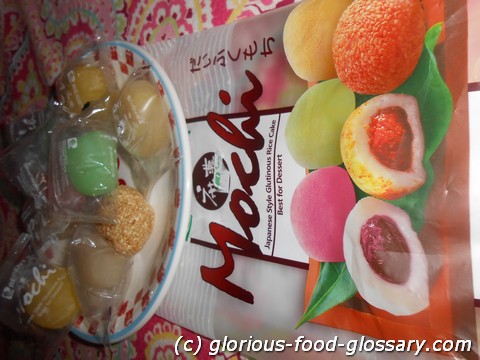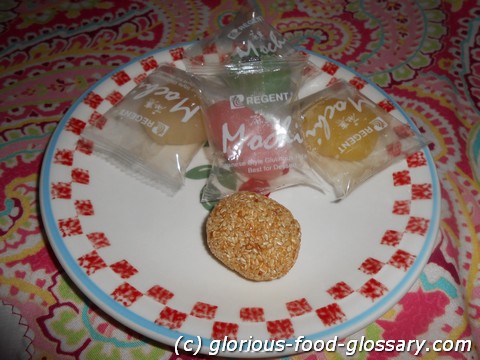Mochi is a traditional Japanese rice cake made from glutinous rice that has been pounded into a sticky and elastic dough-like consistency. This beloved delicacy has a long history in Japan and is known for its chewy texture and mild, sweet flavor. Mochi is used in a variety of culinary applications, both sweet and savory, making it a versatile and cherished ingredient in Japanese cuisine.
Application Areas: Mochi is utilized in numerous culinary applications, including:
- Traditional Mochi: Mochi can be enjoyed in its simplest form, often dusted with kinako (roasted soybean flour) or dipped in soy sauce and wrapped in nori (seaweed).
- Mochi Sweets: It is a common ingredient in various sweet treats like daifuku (sweet filled mochi), ichigo daifuku (strawberry-filled mochi), and mochi ice cream.
- Soup: Mochi is added to ozoni, a traditional Japanese New Year's soup, and other hot soups for added texture.
- Grilled Mochi: Grilled mochi, called yakimochi, is a popular snack or topping for savory dishes.
- Savory Dishes: Mochi can be used in savory preparations such as oden (a hot pot dish) and stir-fries.
Examples of National and International Variations:
- Daifuku (Japan): Sweet mochi filled with various fillings like red bean paste, ice cream, or fruit.
- Chapssal Tteok (Korea): A Korean variation of rice cakes made from glutinous rice and often used in tteokbokki (spicy rice cake stir-fry).
- Nian Gao (China): A Chinese New Year's cake made from glutinous rice, similar to mochi.
Risks:
- Choking Hazard: Mochi's sticky and chewy texture can pose a choking hazard, especially for young children and the elderly. It should be consumed with caution and in small, manageable pieces.
- Caloric Content: Due to its high carbohydrate content, mochi can be calorie-dense, so moderation is advised, especially for those watching their calorie intake.

Recipe - Ichigo Daifuku (Strawberry Mochi): Ingredients:
- 4 large strawberries, hulled and dried
- 4 small portions of anko (sweet red bean paste)
- 1 cup glutinous rice flour (shiratamako)
- 1/4 cup sugar
- 2/3 cup water
- Potato starch or cornstarch for dusting

- Divide the sweet red bean paste into four equal portions and wrap each strawberry with the paste.
- In a microwave-safe bowl, combine glutinous rice flour, sugar, and water. Mix well.
- Cover the bowl with plastic wrap and microwave for 2 minutes.
- Stir the mixture and microwave for an additional 1-2 minutes until it becomes translucent.
- Dust a clean surface with potato starch or cornstarch and transfer the mochi dough onto it.
- Divide the mochi into four equal portions.
- Flatten each mochi piece and place a red bean paste-covered strawberry in the center.
- Wrap the mochi around the strawberry, pinching the seams to seal.
- Serve immediately or wrap with plastic wrap for later consumption.
Examples of Sentences:
- I love to eat a piece of mochi with my green tea.
- The mochi's soft texture makes it a delightful treat.
- We made several batches of mochi for the festival.
- She enjoys grilling mochi for a savory snack.
Similar Foods and Synonyms:
- Tteok: Korean rice cakes that share similarities with mochi.
- Nian Gao: A Chinese rice cake often compared to mochi due to its texture.
- Kakanin: A Filipino term for various rice cakes, some of which are made from glutinous rice.
Articles with 'Mochi' in the title
- Hishimochi / Hishi-Mochi: Hishimochi / Hishi-Mochi: Hishimochi refers to a Japanese sweet with pink, white and green layers which is one of the special foods associated with Hina Matsuri
Summary
Mochi, a chewy and sweet Japanese rice cake, has been a beloved delicacy in Japan for centuries. Its sticky, elastic texture and versatile nature make it a popular ingredient in a wide range of both sweet and savory dishes. Whether enjoyed in traditional forms or incorporated into contemporary culinary creations, mochi continues to be a cherished part of Japanese culture and cuisine.--
Related Articles to the term 'Mochi' | |
| 'Glutinous' | ■■■■■■■■■■ |
| Glutinous is a word to describe something as having the nature of glue sticky, such as Glutinous rice . . . Read More | |
| 'Daifuku' | ■■■■■■■■■ |
| Daifuku is a popular Japanese sweet consisting of a small round mochi (glutinous rice cake) stuffed with . . . Read More | |
| 'Sashimi' | ■■■■■■■■■ |
| Sashimi is a Japanese culinary term for sliced raw fish that often served with pickled ginger, soy sauce . . . Read More | |
| 'Kakanin' | ■■■■■■■■■ |
| Kakanin is a Filipino term used to refer to a wide variety of traditional Filipino rice cakes. These . . . Read More | |
| 'Cornbread' | ■■■■■■■■■ |
| Cornbread is a traditional bread made primarily from cornmeal, which is a coarse flour ground from dried . . . Read More | |
| 'Malagkit' | ■■■■■■■■■ |
| Malagkit refers to glutinous or sticky rice in the context of Filipino cuisine. It is a type of rice . . . Read More | |
| 'Payasam' | ■■■■■■■■ |
| Payasam is a traditional South Indian sweet dish, a type of pudding typically made during festivals and . . . Read More | |
| 'Edamame' | ■■■■■■■■ |
| Edamame are young soybeans that have been harvested before they have ripened or hardened. Typically found . . . Read More | |
| 'Japanese' | ■■■■■■■■ |
| Japanese in the food context refers to the culinary traditions and dishes originating from Japan, characterized . . . Read More | |
| 'Manju' | ■■■■■■■■ |
| Manju is a popular Japanese confection traditionally made from flour, rice powder, and buckwheat and . . . Read More | |
